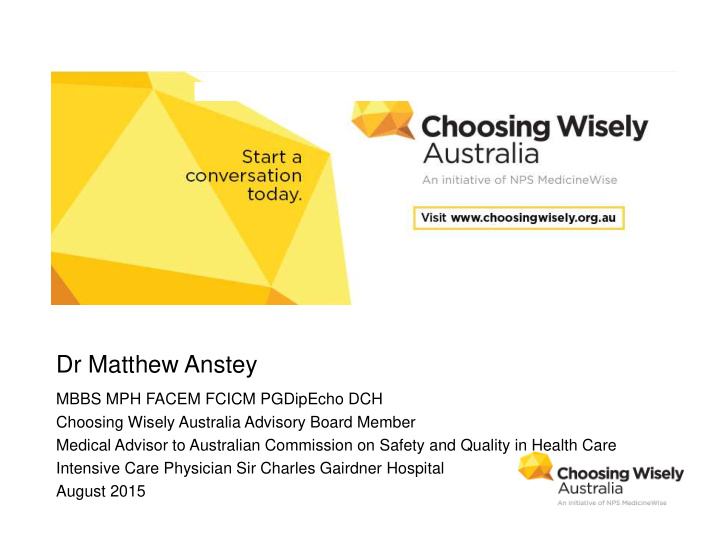



Dr Matthew Anstey MBBS MPH FACEM FCICM PGDipEcho DCH Choosing Wisely Australia Advisory Board Member Medical Advisor to Australian Commission on Safety and Quality in Health Care Intensive Care Physician Sir Charles Gairdner Hospital August 2015
CHOOSING WISELY AUSTRALIA • Starting a national conversation about tests, treatments and procedures that provide no benefit and in some cases may cause harm • Focused on high quality care, supporting conversations between the consumer and clinician • Based on the best available evidence and what care is truly needed • Part of a global movement to assess low value care
Do you agree? • There is a problem with the use of unnecessary tests, treatments and procedures in medical practice. – Strongly agree – Agree – Neutral – Disagree – Strongly disagree
• In your own practice, how often do patients ask for a test, treatment or procedure that you think is unnecessary? • Every day • Several times a week • Once a week • Less than once a week • Less than once a month
Do you agree? • Medical practitioners have a responsibility to help decide on the appropriate use of tests, treatments and procedures? – Strongly agree – Agree – Neutral – Disagree – Strongly disagree
• How much influence do you have in reducing the use of unnecessary tests, treatments and procedures in your clinic or service? – A high level of influence – A moderate level of influence – Some influence – Limited influence – No influence
THE ISSUES • Not all tests add value • Can expose the consumer to undue risk of harm and cost • Consumers are often unaware • Many tests have become ingrained in the system
THE ISSUES • Consumer expectations: ‘more is better’ • Pressure on clinicians to cover all clinical possibilities • 30% expenditure in the US considered wasteful* *reference available on request
Choosing Wisely – United States • Began in 2009 from ABIM • Physician charter for professionalism includes: “commitment to a just distribution of finite resources” • Top Five lists – speciality specific enumerations of five achievable practice changes to improve patient health through better treatment choices, reduced risks, and, where possible, reduced costs. • >50 speciality-specific lists and more than 10 consumer partners • Preserves the pre-eminence of physician judgement, patient choice and therapeutic relationship 9
CHOOSING WISELY AUSTRALIA • Led by Australia’s medical colleges and societies • Facilitated by NPS MedicineWise • Colleges and societies develop lists of recommendations
CHOOSING WISELY LAUNCH Five medical colleges and societies released their recommendations, “5 Things to Question”
LIST DEVELOPMENT • Lists and recommendations are developed and owned by the colleges and societies • List development criteria: – Tests and treatments misused or over used or carry significant cost – Items within the speciality's purview and control – Evidence based – Transparent process
Choosing Wisely Australia • RACGP: long term PPI use, don’t HT/lipids therapy without assessing risk, don’t self monitor type 2 DM oral, don’t screen low risk CV patients, avoid BDZ with history misuse/multiple agents. • ACEM • RCPA : urine cultures, PSA testing & hyperlipidaemia < 7yrs of life, Vitamin D, tumour markers • RANZCR: imaging for ankles, lower spine & cervical spine; duplex ultrasound, PE • Australasian Society Clinical Immunology and Allergy 13
Australasian College for Emergency Medicine • Avoid requesting CT KUB in otherwise healthy emergency department patients, age <50, with known history of kidney stones, presenting with symptoms and signs consistent with uncomplicated renal colic. • Avoid coagulation studies in emergency department patients unless there is a clearly defined specific clinical indication, such as for monitoring of anticoagulants, in patients with suspected severe liver disease, coagulopathy or snakebite. • Avoid blood cultures in patients who are not systemically septic, have a clear source of infection and in whom a direct specimen for culture is possible.
ACEM • For emergency department patients approaching end- of-life, ensure clinicians, patients and families have a common understanding of the goals of care. • Don’t request imaging of the cervical spine in trauma patients, unless indicated by a validated clinical decision rule, such as Canadian C Spine rule or Nexus Low risk criteria. • Don’t request CT head scans in patients with a head injury, unless indicated by a validated clinical decision rule,
REACHING CONSUMERS • Supporting both consumers and clinicians to have conversations about appropriate care • Consumer resources for website • Engaging with consumer organisations
MEDIA COVERAGE • ‘Campaign urges patients, doctors to cut unnecessary tests and treatments ’ ABC News Online • ‘Less is the New More: Choosing medical tests and treatments wisely’ The Conversation • ‘Unnecessary tests: Choosing Wisely campaign targets brain scans, food allergy tests’ Sydney Morning Herald
CRITICAL SUCCESS FACTORS • Health profession-led, collaborative approach • Consumers at the centre • List development and ownership driven by colleges • Talking to patients : ‘Quality’, ‘reducing risk of harm’ and ‘waste’ resonates • Implementation and evaluation
Recommend
More recommend